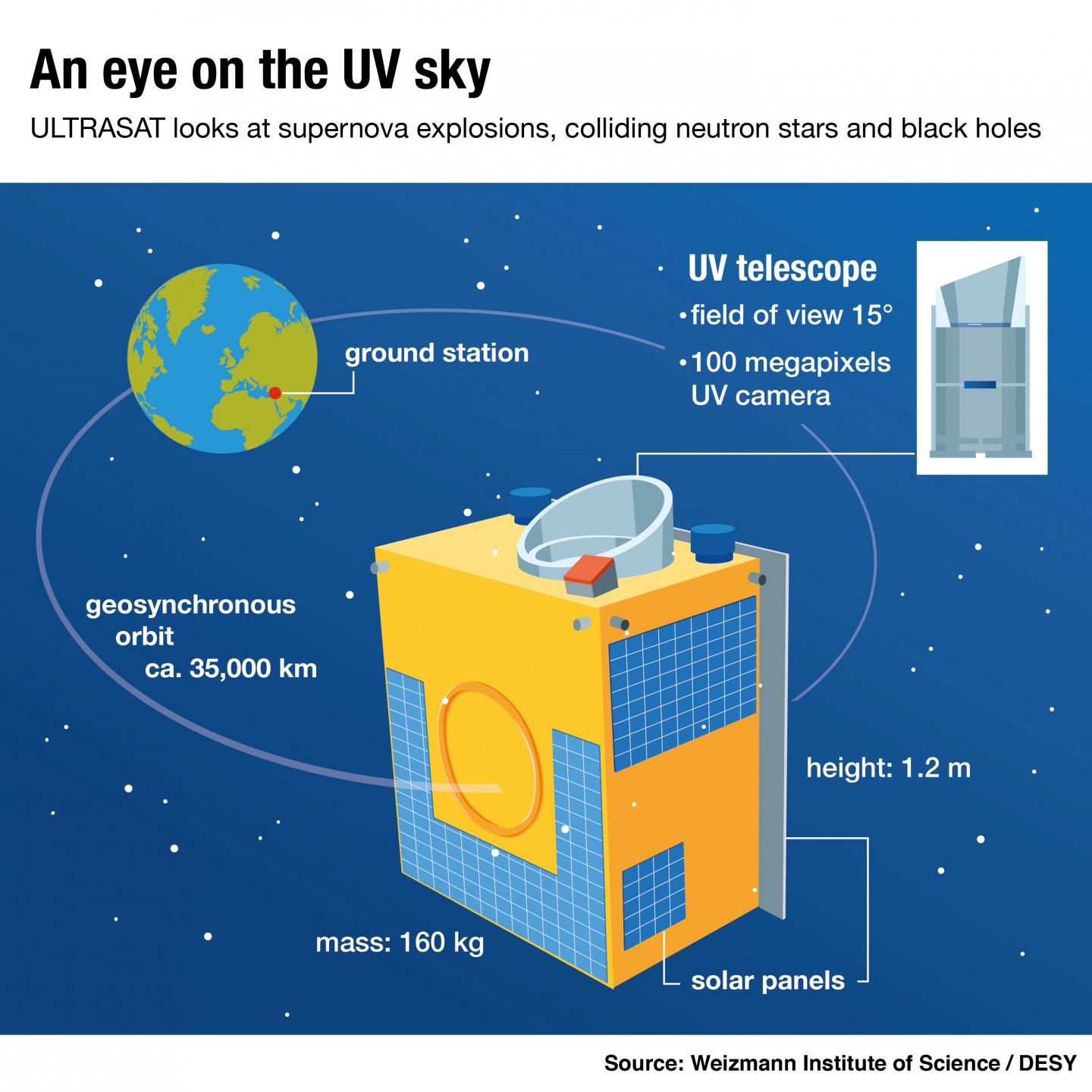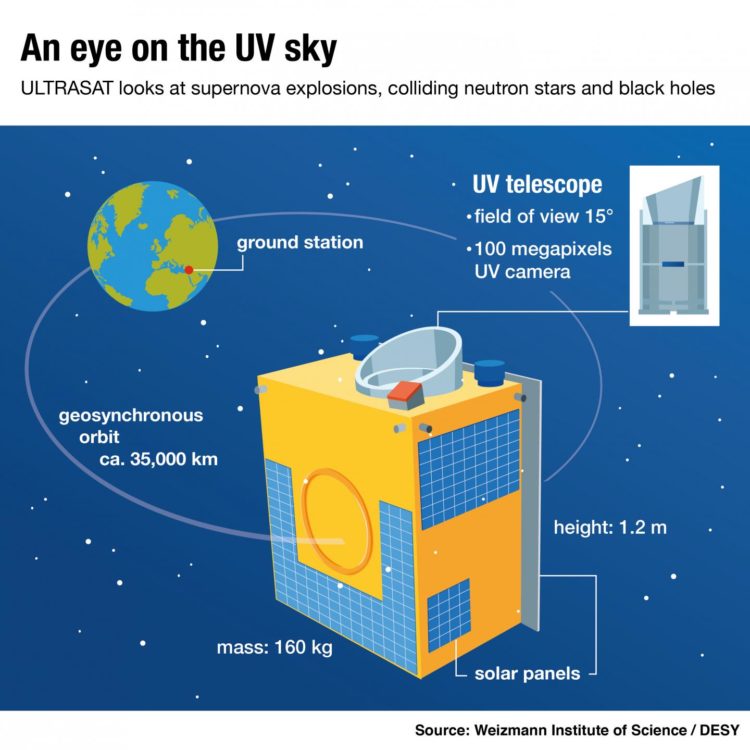DESY to build 100-megapixel camera for Israeli space telescope

Credit: DESY, Sven Stein
A new space telescope will open up an unprecedented view of the universe in ultraviolet light: The ULTRASAT satellite will provide fundamental new insights into high-energy phenomena such as supernova explosions, colliding neutron stars and active black holes, all of which can also generate gravitational waves and act as cosmic particle accelerators. On Monday in Rehovot, Israel, the President of the Helmholtz Association, Otmar D. Wiestler, and the Director of the Helmholtz centre DESY, Helmut Dosch, agreed with the Weizmann Institute of Science on a cooperation for German participation in the Israeli-led project. DESY will build the 100-megapixel UV camera for the space telescope. For the project, DESY is working with the German Aerospace Center DLR, which also is a member of the Helmholtz Association.
“Helmholtz has had many excellent scientific collaborations with Israeli partners for decades. Together with the Weizmann Institute of Science, we are now taking another important step in the field of astrophysics. I am extremely pleased about this,” said Helmholtz President Otmar D. Wiestler. “The cooperation on the ULTRASAT space telescope has the potential to create a completely new basis for the detection of gravitational waves and related astrophysical events, at the highest international level.”
DESY Director Helmut Dosch added: “We have a long and fruitful cooperation with a number of Israeli partners. We are now continuing this success story with our participation in Weizmann Institute of Science’s challenging satellite project.” DESY’s Research Director for Astroparticle Physics, Christian Stegmann, emphasised: “ULTRASAT offers us unique insights into the high-energy universe. With the camera for the telescope, DESY will be able to combine and contribute its outstanding expertise in detector development for astroparticle physics and X-ray physics.”
ULTRASAT will study the sky in the ultraviolet range (220 to 280 nanometres wavelength) of the electromagnetic spectrum and have a particularly large field of view of 225 square degrees – about 1200 times as large as the full moon appears in our sky. “This unique configuration will help us answer some of the big questions in astrophysics,” said Eli Waxman, principal investigator of ULTRASAT at the Weizmann Institute of Science.
For example, the satellite will search for the origin of the heavy chemical elements. Apart from the lightest elements like hydrogen and helium, the elements were almost exclusively created by nuclear fusion in the cosmos. Stars produce their energy from this nuclear fusion, but this only works up to iron. The fusion of heavier elements such as lead or gold costs energy. Their synthesis takes place in the most powerful processes in the universe, such as the explosion of a star as a supernova or the collision of two neutron stars – the nuclei of burnt-out suns that have collapsed under their own weight to such an extent that they have a density like a gigantic atomic nucleus. Every gold atom on Earth and in the rest of the cosmos comes from an exploding sun or from a neutron star crash.
“We want to understand exactly how the elements are produced and how they are distributed,” explains David Berge, Lead Scientist at DESY. Both, supernova explosions and neutron star collisions can be followed particularly well in UV light, as Berge points out. “The direct phase of a supernova in the first minutes, hours and days is mainly seen in the UV. During this time, the UV light contains characteristic signatures that indicate the predecessor star.” Later, a shockwave breaks out of the hot fireball, within which charged subatomic particles are also accelerated to high energies. “The satellite can therefore help us to understand the origin of such cosmic particle accelerators,” says Berge. “We also want to find out which type of star explodes in which kind of supernova.”
ULTRASAT is particularly sensitive to high-energy phenomena. “Everything that gets extremely hot shines brightly in the UV light,” reports DESY researcher Rolf Bühler, project manager for the UV camera. This includes active black holes, which absorb matter from their environment and also accelerate particles, and colliding neutron stars. The observation of neutron star crashes can not only provide information about element synthesis in the cosmos, but is also of great importance for gravitational wave research. “If gravitational waves are registered by merging neutron stars, their position can so far only be coarsely resolved on the basis of the gravitational wave data,” explains Bühler. “ULTRASAT can orient itself to the target region within a maximum of 30 minutes and, thanks to its large field of view, can then determine the exact position almost immediately.”
The satellite thus has a decisive function for the young field of multi-messenger astronomy (MMA), which studies the universe via various messengers such as cosmic particles, gravitational waves and electromagnetic radiation and forms a new area of research at DESY. With its large field of view, the satellite will have a particularly large section of the sky in view and will thus also be able to detect unknown objects that suddenly flare up in the UV range.
With a total weight of only 160 kilograms and a volume of less than one cubic metre, ULTRASAT (Ultraviolet Transient Astronomy Satellite) is a small scientific satellite. The Weizmann Institute of Science and the Israeli Space Agency ISA share funding and management. The launch is scheduled for 2023. The space telescope will then collect data for three years. It will be put in a high orbit about 35,000 kilometres above Earth’s surface. This guarantees that disturbances from the ultraviolet background radiation, which Earth’s atmosphere reflects from the sun, are negligible and allows large areas of the sky to be surveyed. UV radiation can only be observed from orbit because it is largely absorbed and reflected by the atmosphere.
The UV camera, which DESY is developing and building, will be the heart of the telescope. It will have a UV-sensitive sensor area of nine by nine centimetres and a resolution of 100 megapixels. With these parameters, the developers are breaking new ground: A UV space camera with such a resolution and sensitivity has never been built before. For the camera, DESY experts in astroparticle physics work together with specialists in detector development from the field of research with synchrotron radiation. With this project, DESY is contributing about 5 million euros to the satellite, which will cost about 70 million euros in total.
###
DESY is one of the world’s leading particle accelerator centres and investigates the structure and function of matter – from the interaction of tiny elementary particles and the behaviour of novel nanomaterials and vital biomolecules to the great mysteries of the universe. The particle accelerators and detectors that DESY develops and builds at its locations in Hamburg and Zeuthen are unique research tools. They generate the most intense X-ray radiation in the world, accelerate particles to record energies and open up new windows onto the universe. DESY is a member of the Helmholtz Association, Germany’s largest scientific association, and receives its funding from the German Federal Ministry of Education and Research (BMBF) (90 per cent) and the German federal states of Hamburg and Brandenburg (10 per cent).
Media Contact
Thomas Zoufal
[email protected]
49-408-998-1666
Original Source
https:/





